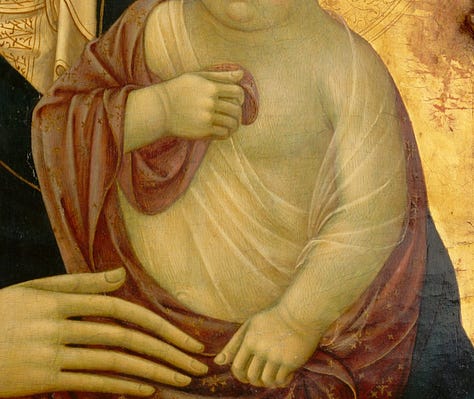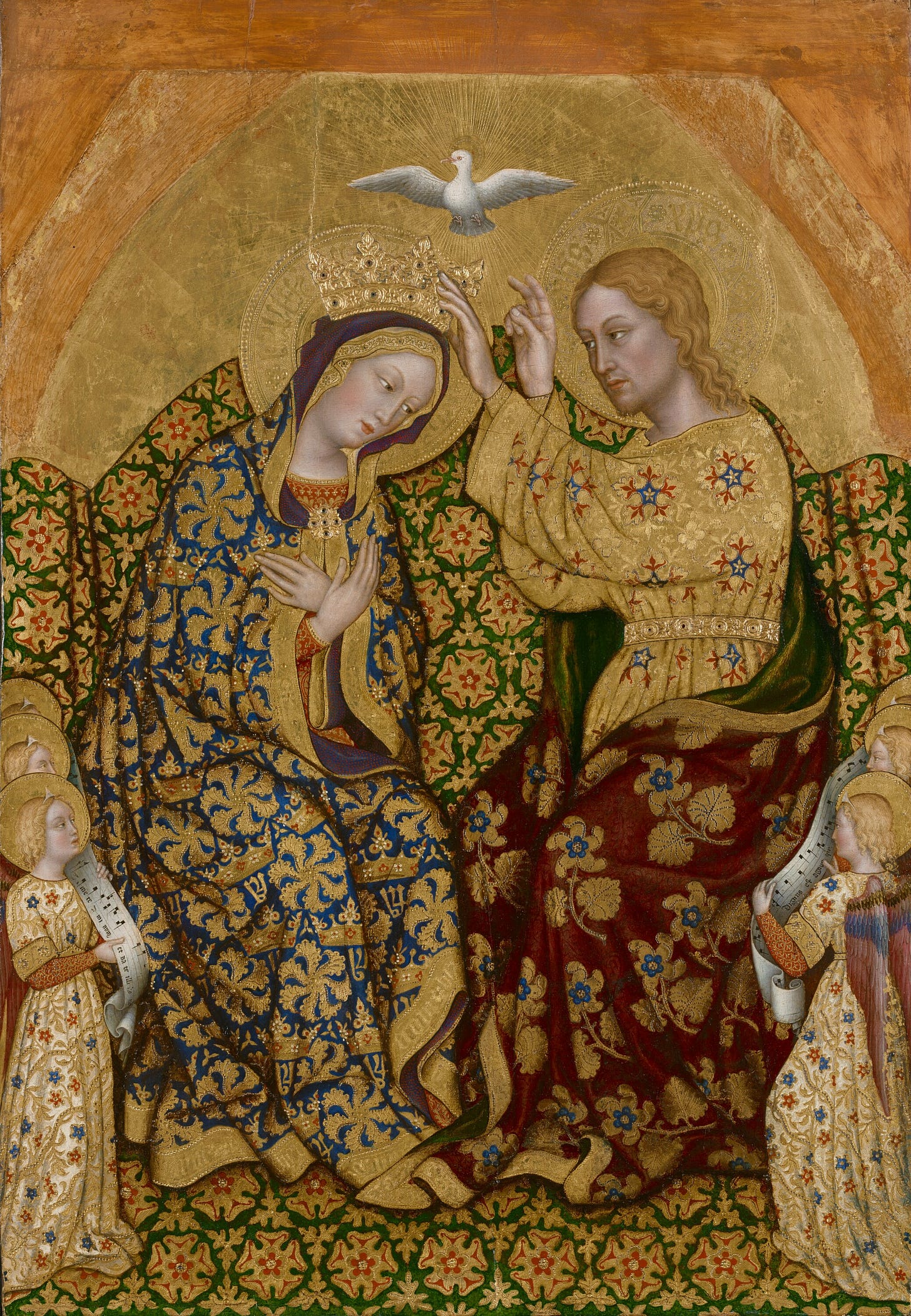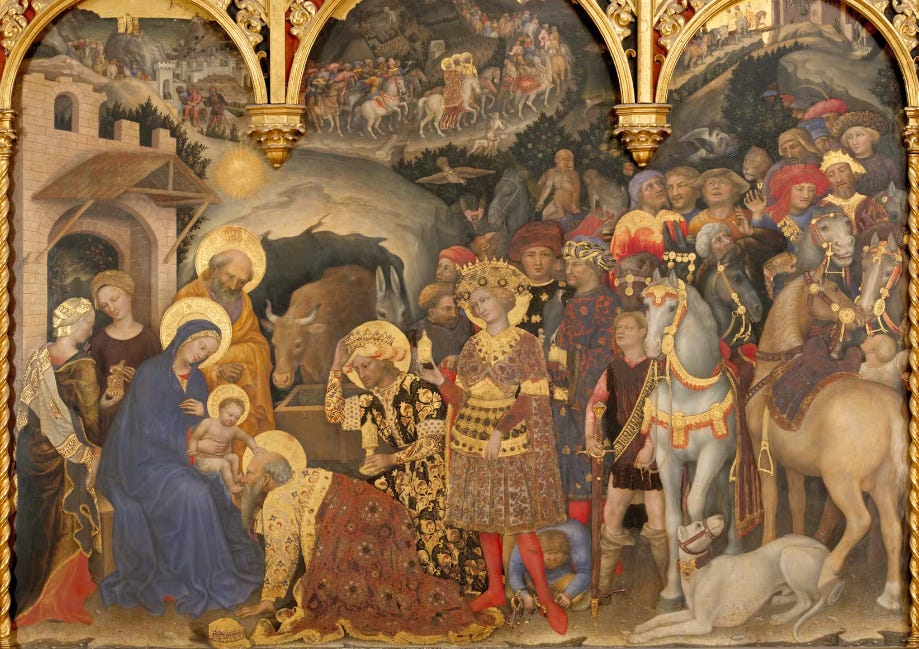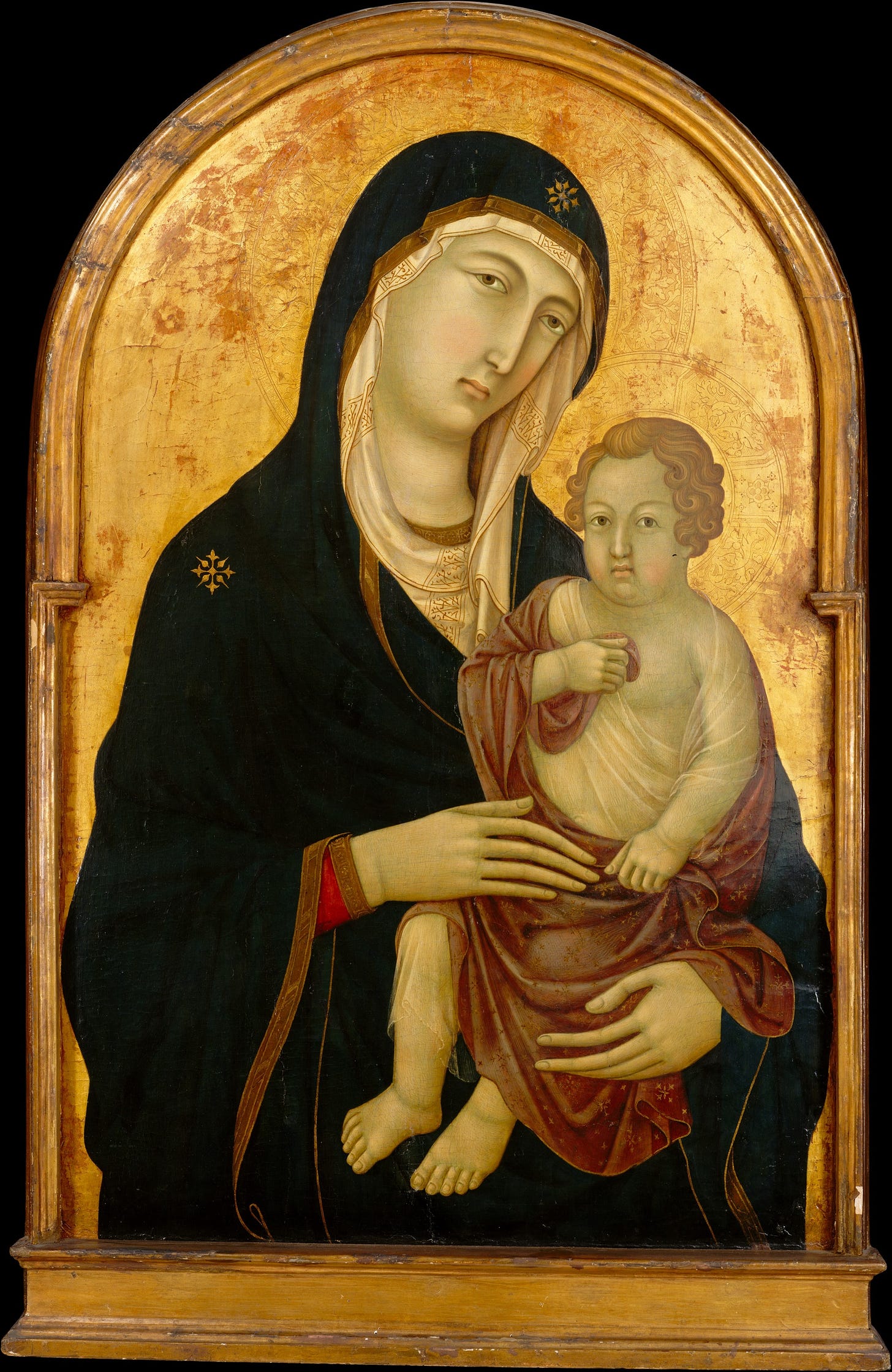Artist focus: 3 Gothic masters you've probably never heard of
More Gothic eye-candy from the 14th & 15th century

The Gothic period in Italy is gravely under-sung, and often passed over for its own merits as just a step toward the great Florentine Renaissance. But this era was rich with its own artistic innovation and expressive power, as seen in the works of painters like Gentile da Fabriano, Lippo Memmi, and Ugolino di Nerio, our three featured painters today. These names are not widely known in the Anglosphere, but they exemplified the Italian Gothic style, with its rich, intricate detail, softly modelled faces and gentle, serene expressions, vibrant, jewel-like colours, and symbolic, rather than naturalistic forms - all reflecting deeply spiritual themes.
Gentile da Fabriano1, celebrated for his sumptuous use of gold and delicate figures, captured the essence of the International Gothic style in masterpieces like the "Coronation of the Virgin." Lippo Memmi, a key figure in the Sienese school, was renowned for his elegant compositions, flowing lines, and emotional depth, as seen in his altarpieces that exude a graceful and lyrical quality. Ugolino di Nerio, another prominent Sienese painter, balanced his works with a strong devotional intensity and delicacy of brushwork, making his religious figures particularly evocative.
In today’s post for all subscribers, we’re going to take a look at three great Italian Gothic painters who are less known outside Italy, Gentile da Fabriano, Lippo Memmi and Ugolino di Nerio.
The Sacred Images Project is a reader-supported publication where we talk about Christian thought, life, history and culture through the lens of the first 1200 years of sacred art. It’s my full time job, but it’s still not bringing a full time income, so I can’t yet provide all the things I want to and am planning for. You can subscribe for free to get one and a half posts a week.
For $9/month you also get the second half of the Goodie Bag, plus a weekly paywalled in-depth article on this great sacred patrimony, plus extras like downloadable exclusive images, ebooks, mini-courses, photos, videos and podcasts (in the works).
If you would prefer to set up a recurring donation in an amount of your choice, or make a one-off contribution, you can do that at my studio blog, where you can also browse my shop for prints and other items from my own drawing and painting work:
Gentile da Fabriano - c. 1370 – 1427

An example of the Italian branch of the International Gothic style, marked by an emphasis on elegant lines, rich colours, lots and lots and lots of gold, using every imaginable decorative technique. Gentile da Fabriano was the most important Italian painter of his day, known for his exquisite handling of these elements, creating works that are both intricate and harmonious.
The Getty’s excellent high resolution photography allows us to examine the gold work and painting technique extremely closely.




Probably his most famous work is the Adoration of the Magi, the central panel of an altarpiece now held in the Uffizi in Florence.



Lippo Memmi (Filippo di Memmo) - c. 1291 – 1356
best known as the foremost follower, collaborator and brother-in-law of the renowned Sienese Trecento artist, Simone Martini.
Son of the Sienese painter Memmo di Filippuccio, Lippo, short for Filippo, he was born near the end of the thirteenth century and trained in his father’s workshop. His earliest signed and dated work (1317), the Maestà, is in the Palazzo Pubblico in San Gimignano, the city where his father was long active.

Similar in composition and style to the more famous version of the same theme painted two years earlier by Simone Martini in the Palazzo Pubblico in Siena. The two are similar enough to indicate active collaboration between the two, including working on the same commissions, as in the case of the Annunciation side panels.

Simone Martini married Lippo’s sister in 1324.





The stylistic kinship between the two brothers-in-law is so close as to make it difficult to distinguish the work of the one from the other. But his artistic importance emerges from his various signed works.
After the Virgin in the San Gimignano Maestà, Lippo developed a delicate style, combining linear elegance and subtle modelling typical of the masters of the Sienese Trecento. Some of his finest works are held by the Metropolitan Museum in New York, and consist of half-figures of saints and the Virgin and Child, in a distinctive iconographic style.




Ugolino di Nerio (b. late 13th c. active 1317 - 1327.)
Ugolino was a significant Sienese painter from the early Trecento. Though his exact birth and death dates are uncertain, he's considered one of the most devoted followers of the renowned Sienese artist, Duccio di Buoninsegna. Where the later Gentile da Fabriano can justly be described as a transitional painter heading towards a more naturalistic style typical of the later Renaissance, Ugolino was deeply embedded in the Gothic iconographic style.


Ugolino was a member of a family of artists, that included his father and brothers, Guido and Muccio. Ugolino probably trained with Duccio and then ran an important workshop in Siena. He is documented in Siena between 1317 and 1327 and according to Vasari died between 1339 and 1349.



Ugolino's most important major work was the altarpiece for the church of Santa Croce in Florence, which was broken up. The National Gallery in London holds a number of the panels.


Enjoy the National Gallery’s full collection of Santa Croce Altarpiece panels here.
How was it done?
I found this fascinating video series by the National Gallery London giving a lot of detailed information from their research labs on how magnificent paintings like the Maestà were created. For me, part of the awe I feel when I’m face to face with them is wondering how on earth objects like this could possibly have been made. I’ve been reading and learning about traditional gold work techniques and have been trying a few things myself. The skill level of these medieval craftsmen is truly staggering.
Of course back in the days of the great masters like Duccio, the painter whose name is associated with a work was the front man for a whole company, a workshop employing many expert craftsmen. Duccio di Buoninsegna would not have made his own panels, or done the gilding and tooling and decorating.
A few years ago I bought the book the National Gallery produced way back in 1990, that goes with the video series and have been using it as a reference for my own work. But I actually had no idea there were videos that went along with it until the other day. So if you really want to get an in-depth look at these incredible Italian Trecento techniques, in great detail, with photos from their extremely in-depth scientific analysis - x-rays and electron scanning microscope photos, minute analysis of the pigments, mediums, varnishes and other materials - you can’t do better than to get this book. Its out of print, but there are still copies floating around.
From, as the name suggests, the small town of Fabriano, in La Marche, famous to this day for its specialty industry, paper making.















This substack is such a blessing.
Thanks for writing this. I've thought images of this nature (i.e. right before Renaissance) were a little bit "weird" when compared to the more naturalistic stuff. Your content is really helping me reframe that and see the continuity to prior art/iconography -- and although not an artist myself, understanding how these were made is awe-inspiring.